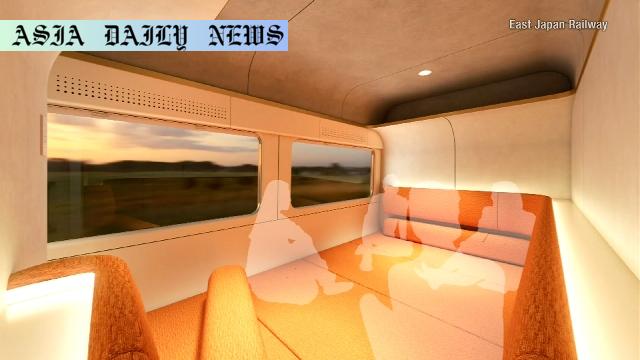Overnight train: East Japan Railway’s new service to connect Tokyo with Aomori will redefine night travel in private compartments.
- East Japan Railway plans a new overnight train connecting Tokyo and Aomori by 2027.
- The train offers private compartments accommodating up to four people.
- This service replaces the retiring ‘Cassiopeia’ and promotes tourism in Tohoku.

Introduction: A New Era in Overnight Rail Travel
East Japan Railway (JR East) is set to redefine overnight train travel with its announcement of a new express train connecting Tokyo and Aomori. Scheduled for launch in the spring of 2027, the service promises to bring convenience, luxury, and innovation to long-distance commuters and travelers. This comes at a time when JR East is bidding farewell to its renowned ‘Cassiopeia’ sleeper express, which for years connected Tokyo to Hokkaido.
Luxury and Privacy at the Forefront
One of the standout features of the new overnight train is its private compartments. These rooms, designed for individuals or groups of up to four, include fully reclining seats to ensure maximum comfort during the 12-hour ride. The concept aims to provide a refined overnight experience, merging privacy and luxury. Passengers can travel while enjoying personal space, making it ideal for families, professionals, or tourists looking for a restful journey. JR East President Kise Yoichi emphasized that the service would introduce a fresh perspective on night travel by emphasizing comfort and exclusivity in private settings.
A Seamless 12-Hour Journey Between Tokyo and Aomori
The train will depart Tokyo at 9 p.m. and arrive at Aomori Station by 9 a.m. the next morning. The service will convert an existing express train on Tokyo’s Joban Line into a more modern and luxurious ten-car overnight train. This effort not only preserves existing infrastructure but also enhances it to meet contemporary demands. The service aligns with Japan’s reputation for punctual, high-quality rail experiences, ensuring an unforgettable journey for its users.
Boosting Regional Tourism and Attracting Foreign Visitors
JR East sees this service as more than just a means of transportation—it is also a strategic move to boost tourism, particularly in the Tohoku region. CEO Yoichi expressed his hope that the innovative service would attract an influx of foreign visitors who wish to explore the beauty and culture of the region. This move comes amid efforts to revitalize Tohoku’s economy and make it a more prominent destination for global travelers. The new service could also spark interest in sustainable transit options, reinforcing Japan’s dedication to environmental consciousness.
What Lies Ahead: Challenges and Opportunities
While the announcement has generated significant excitement, certain details remain undecided, such as the train’s fare structure, name, and service frequency. These factors could heavily influence the service’s overall appeal and accessibility. Additionally, as JR East embarks on converting the Joban express train into this ten-car overnight marvel, the company must ensure balances between affordability and luxury to cater to a diverse customer base. Nonetheless, with its unique selling points and the strong infrastructure of Japan’s rail network, the initiative appears well-poised for success.
Conclusion: A New Dawn in Rail Travel
JR East’s new overnight express train symbolizes innovation and refinement in rail transportation. By bridging Tokyo and Aomori with an overnight service that prioritizes privacy, comfort, and exclusivity, the company is setting a new standard. This project not only provides a replacement for the beloved ‘Cassiopeia’ sleeper but also presents exciting opportunities for regional connectivity and tourism growth in Japan. As the world waits eagerly for 2027, this initiative is destined to become a key milestone in modern travel.



Commentary
An Ambitious Leap into the Future of Travel
East Japan Railway’s latest announcement about the overnight express train illustrates a perfect example of innovation meeting tradition. As modern transportation evolves rapidly, JR East’s decision to focus on overnight services demonstrates the company’s commitment to creating unique travel experiences. The emphasis on private compartments reflects an understanding of the evolving traveler’s preferences, particularly regarding safety, comfort, and personalized services. In designing this train, JR East has struck an incredible balance, appealing to both domestic users and international tourists seeking convenience and exploration.
Enhancing Regional Tourism with Elegance
The connection between Tokyo and Aomori is significant not only as a vital transportation route but also as a gateway for tourism. By revamping overnight rail travel and bringing in private accommodations, JR East appears to be doubling down on the potential for attracting adventure seekers and families alike. This move could prove monumental for the underappreciated Tohoku region, showcasing its untapped potential as a tourist hotspot. The strategic alignment with Japan’s broader goals of attracting international visitors further underscores the thoughtfulness of this project.
Opportunities for Future Growth
While the announcement holds immense promise, there remain hurdles to overcome. The project will need competitive pricing for ticketing to appeal to various demographics while ensuring the operational and infrastructural cost remains sustainable. Moreover, refining operational schedules to accommodate customer needs while maintaining punctuality is essential. However, the sheer boldness of the concept suggests that JR East is keen on setting benchmarks for premium services in the rail industry, and one can expect it to deliver a world-class experience.
Conclusion
JR East’s venture into crafting an exclusive overnight train is a step in the right direction, merging luxury with practicality. The announcement taps into the broader narrative of innovative travel and regional upliftment, promising to rejuvenate the allure of rail journeys. As 2027 approaches, this ambitious project sets the stage for redefining overnight travel in the region, positively impacting tourism, transportation, and international visitor experiences in Japan.